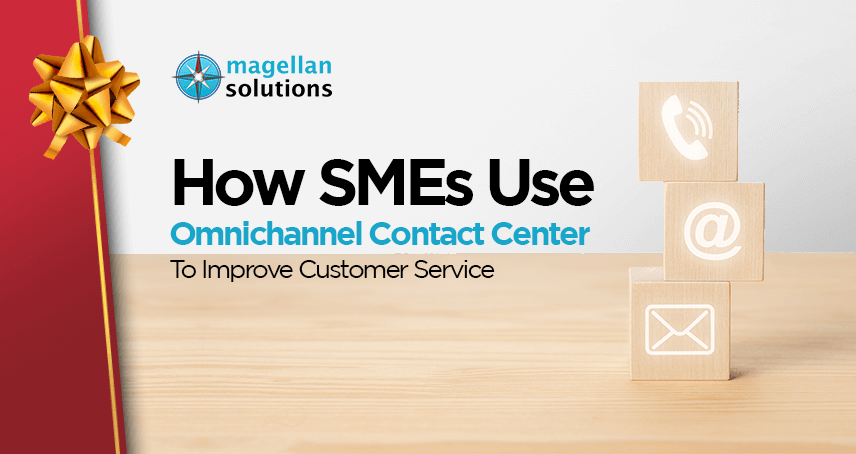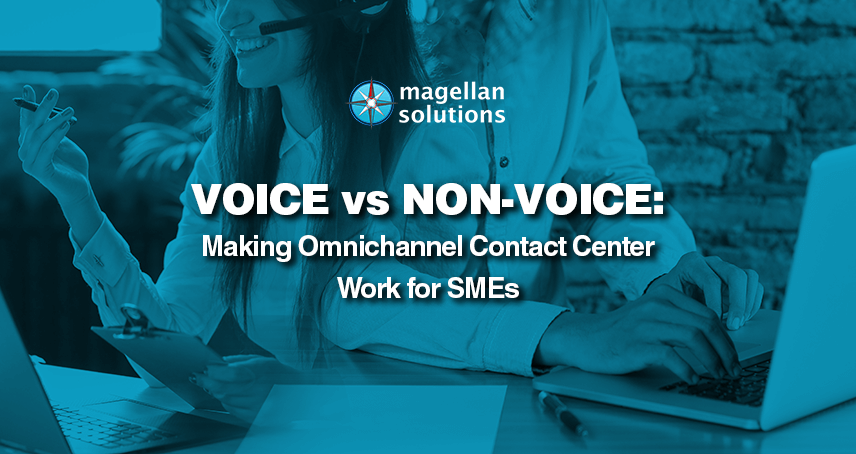Schedule a FREE call with our outsourcing expert now and get a precise quotation that meets your requirements. Don't wait - get started today!
Empower Your SME with Omnichannel Contact Centers
As business practices continue to evolve, customer service is also transforming, expanding its channels to deliver exceptional service in multiple ways. One emerging practice is the omnichannel contact center for SMEs.
Among the many innovations in customer service and all its channels, omnichannel contact centers are one of the most recent (and the most effective) in terms of assistance and covering more ground.
What is an Omnichannel Contact Center?
An omnichannel contact center is a business function operating under a hosted, cloud-based software.
As the name suggests, this cloud-hosted contact center handles all communication—phone calls, online chats, emails, SMS (texts), and social media.
Relatively new to the scene, omnichannel contact centers are slowly making their way into normalcy and in popularity due to the rapid digitization of many business functions over the years.
While it’s a widespread belief that only larger-scale businesses can outsource many of their business functions, the opportunity has expanded to small and medium-sized enterprises as well, with the rise of omnichannel call center providers for SMEs catering specifically to businesses of this size.
Voice or Non-Voice: What is Best for Small Businesses?
Omnichannel contact center for SMEs are developed to cover all bases and open communication lines.
Over the years, many innovations have been created to make customer services more effective and accessible to customers by demand.
Customer service has become more modern and convenient in real-time than traditional phone call correspondences.
When selecting customer support for the enterprise, consider the available communication media.
While more traditional, voice support is still a preferred mode of communication by many customers, as speaking to a live agent gives them an impression of urgency and more time and room for other concerns.
On the other hand, non-voice support is preferred by most of the younger, more technologically inclined customer base, as chatting and messaging on online websites and apps appeal more to their definition of accessibility and need for instant gratification.
Other than determining what type of support your business needs through internal factors, learning more about your market and your customer base is essential to figuring out a much more effective way to reach and communicate with them.
Factors To Consider
Every decision you make for your business is a calculated risk, particularly if you’re expanding your enterprise in its early years.
This is why it’s essential to continue exploring possibilities for fine-tuning business operations and innovating ways to expand your enterprise.
Excellent customer experience is the foundation of a good relationship with regular and potential customers.
While seemingly a simple task, creating a good rapport with your customers through pleasant customer service maintains a good impression with customers and associates your business with convenience and quality service – essential and greatly helpful in establishing customer loyalty.
Now that customer service comes in all forms, it’s time to decide which is best for your type of enterprise. Consider the nature of the business, its size, and the services offered.
To determine which channel is right for your business, let’s examine these factors:
Nature of Business
Voice and non-voice support aim to assist customers and tackle concerns. Both may be essential to your business in terms of boosting your accessibility. However, it still largely depends on the nature of your business and, by association, your type of customer service.
Voice support conveys urgency and accessibility and is a preferred mode of customer service.
Voice support is ideal for technical businesses, as the technology industry always has numerous concerns to address, such as internet service and mobile app support.
Customer Base
Your customer persona plays a significant role in your customer experience—after all, the function exists to keep customers happy and interested.
While voice support may seem more familiar, the more tech-savvy generation nowadays prefers non-voice support – chats, messages, SMS, emails – to reach out for customer service.
Knowing your customer base and choosing the suitable customer service medium is essential.
Cost-Efficiency
Allocating funds wisely is essential for a growing SME such as yours. Investments may seem like an expense initially, but soon, you’ll find yourself reaping the generous benefits.
While every entrepreneur always chooses the option with the most value but the least expense, ensuring the investment fits well into the business is essential.
Regarding operational expenses, voice support is more costly than non-voice support. We hire and compensate agents; incidental costs factor in the rate packages, especially for exceptional cases such as after-hours and 24/7 customer support.
This depends, however, on the nature of the business. Voice support is ideal for technical help, order-taking, and similar tasks, providing more room for in-depth communication.
Non-voice support is far less costly, as it is mainly accomplished through apps and software, without necessitating constant manning due to some options being automated.
This is ideal for logistics, food, and booking services, which take little time and often use simple communication.
Level of Responsiveness
Voice and non-voice support differ in responsiveness, as customers have varying standards for effective support.
Voice support is ideal for urgent concerns and issues requiring swift and practical guidance from a live agent.
For SMEs in the financial services industry – loaning apps, payment channels, e-wallets, etc. – voice support would be ideal, as customers are very particular about addressing concerns regarding finances and payments.
Non-voice support is best for concerns that need an immediate response that does not necessarily require a complex course of action.
For small businesses in retail, food delivery, hospitality, and other similar industries, non-voice support channels such as chatting and messaging apps can make the ordering, delivery, and booking process more convenient.
While live chatting agents man, some, many non-voice multichannel contact center solutions often include automated answering and interactive features that allow customers to place/request services themselves.
Cover All Bases for Your SME
Business solutions continue to evolve and cover more ground regarding business functions, and the good news is that it’s not only reserved for larger firms.
Omnichannel contact centers benefit SMEs, making covering all bases more convenient and linear. As a growing business, it helps to be more organized without compromising efficiency.
As outsourcing is much more accessible and feasible, it’s time to step up the ante and acquire reliable omnichannel contact center solutions to boost customer service for your fast-growing business.


Magellan Solutions is a Provider of High-Quality Omnichannel Contact Center for SMEs
Magellan Solutions is an ISO-certified provider of prime call center business solutions in the Philippines. We offer a wide range of outsourced call center services – top-tier omnichannel contact center solutions, phone answering services, technical support, etc.
Put your customer service in expert hands. With 18 years of industry experience and hundreds of satisfied SMEs, we can guarantee quality service for your growing enterprise.
Let’s explore what we can do for your business today. Contact us here for more info.














